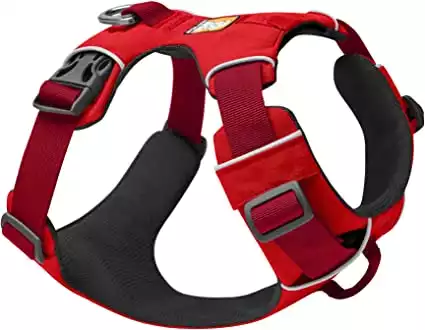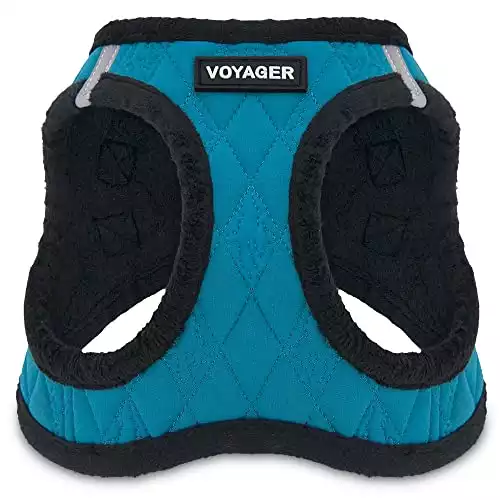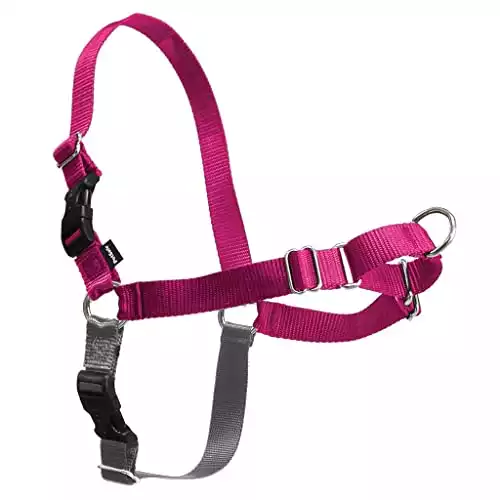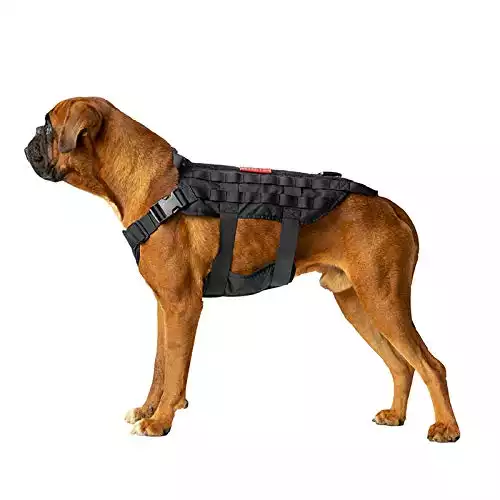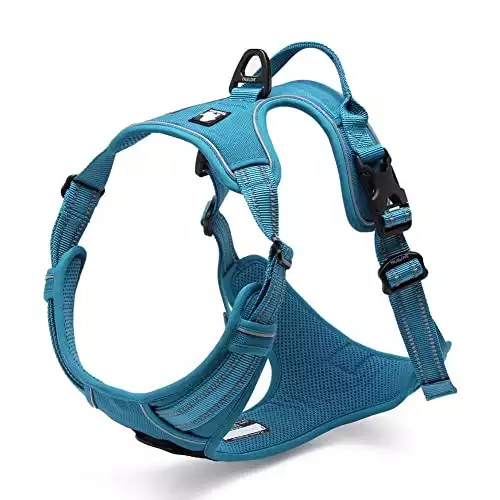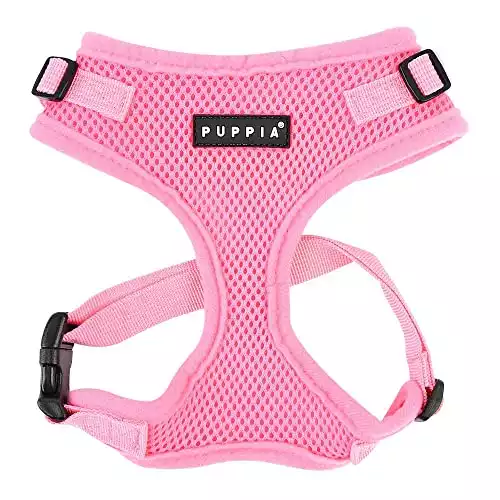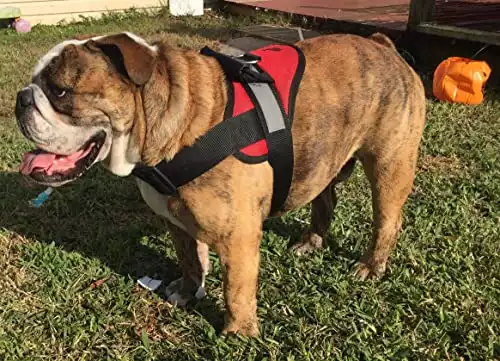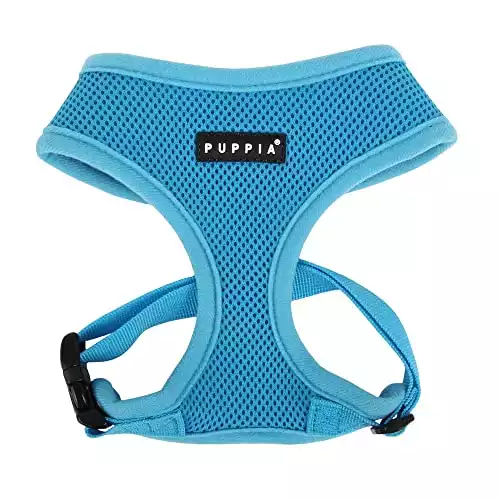Best Harness for Dobermans
March 6, 2022 2022-03-06 7:57As an Amazon affiliate we earn a small commission from qualifying purchases. We only recommend products we have tested and are using on our own dogs!
Harnesses come in handy in many situations. From long line work over leash training to puppy training, they have many uses and applications.
Luckily, there are many harness options out there – even for dogs as big as a Doberman. However, that doesn’t mean that all of the harnesses out there are suitable for your Doberman. We took a look at some of the best harnesses in this article so that you select the best option for your canine.
Best Harness for Dobermans
The four adjustment points in the Ruffwear Front Range allow you to customize the fit.
The all-over foam padding is perfect for short-coated dogs, helping to ensure the harness does not rub or chafe. The reinforced leash-attachment points are built tough to stand up even to a dog that pulls!
The reflective trim will help keep your dog AND you safe in low-light conditions. The ID pocket lets you store your dog's tags to help keep them safe if you're separated.
The y-front style of the Ruffwear Front Range will keep your dog's shoulders unencumbered, allowing them to extend naturally and move freely.
Table of Contents

Mini-reviews of our other top picks
If our favorite product isn’t quite what you’re looking for, why not try one of our other top picks?
Best Harness for Doberman Puppies
First and foremost, the Best Pet Supplies Voyager Dog Harness is designed to fit dogs of many different shapes and sizes. It comes in multiple different sides and is also quite adjustable - a big plus for growing puppies!
It doesn’t rub or irritate your pooch as some other dog harnesses might.
Furthermore, it also provides quite a bit of padding, leading to long-lasting comfort even when your pooch is wearing it for extended periods at a time. The panels are made from the ultra-plush lining, though it is also quite breathable.
We also loved that this harness is machine washable. Therefore, if your dog ends up getting dirty on your adventures, you can quickly clean this dog harness back up.
Best Minimalistic Harness
You don’t always want a large, complicated harness.
If you’re just looking for something to walk your dog on, then this harness is perfect for you. This harness has a D-ring near your dog’s chest. You attach the leash to this ring, and then it prevents your dog from pulling.
Furthermore, this harness also prevents pulling on your dog’s neck, since it isn’t attached around your dog’s neck at all. It makes walking much more stress-free.
The quick-snap buckles allow you to easily take this harness off and on – even if your canine is struggling. The straps are color-coded, making it easier to tell which strap goes well. The Martingale loop on the chest prevents the strap from twisting – further making the harness quite easy to put on. You don’t have to worry about fixing the twisting while trying to put the harness on your canine.
While this harness comes in many different size options, it also features four different adjustment points, which provide maximum comfort and a reliable fit.
Best Tactical Harness for Dobermans
There are several different types of harnesses out there. One of the most popular kinds is the tactical harness, which often has a military-style. The One Tigris Tactical Vest Dog Harness is one of the best tactical harnesses out there, so we highly recommend it for those looking for this style of vest. It is designed to keep your canine comfortable, while also providing some extra practical features.
It features a heavy-duty nylon shell, which helps keep your canine safe while on the trail. It also features soft, interior lining for a comfortable fit. It is lightweight but quite durable. Plus, it is also extremely water-resistant, so it should be able to withstand quite a bit of moisture.
It also features MOLLE webbing along both sides, allowing you to equip it with your typical MOLLE pouches. Depending on the ones that you choose, your canine may be able to carry their own equipment.
The neck and chest strap can both be adjusted for a secure and comfortable fit.
The fastener-style panels are fuzzy on all three sides, allowing you to attach a range of different patches and badges to the harness. You can use it to express your individuality and your pup’s style.
Best Outdoor Harness
While it wasn’t one of our absolute favorites, we still liked this dog harness by Chai’s Choice. It is designed for outdoor use and is reflective, which is a feature that is surprisingly hard to find amongst dog harnesses. If you do a lot of walks at night, this dog harness is probably one of the better harnesses. The reflective material makes it much easier to see your dog at night, which can prevent them from getting hit by a car.
This harness is also cushioned to take as much weight off of your dog as possible. The lightweight, mesh padding is breathable while providing comfort throughout their chest and belly. The exterior is nylon, which is water-resistant and more durable than most materials.
Of course, all the straps are adjustable to provide the best fit possible for your canine. There are nine different color options available and various sizes, allowing you to customize this harness for your needs.
Plus, we also liked that this harness has a chest-mounted O-ring. If your dog is prone to pulling, you may be able to utilize this harness to make walks a bit more peaceful.
Best Budget Option
Designed for everyday use, the Puppia Polyester Back Clip Dog Harness is meant to be both comfortable and functional.
This harness is lightweight and made with a large, comfortable neck opening.
The chest belt is completely adjustable to provide the perfect fit, and it is quick-release, making it perfect for dogs that tend to struggle when getting their harness out on or taken off.
The padding is made of mesh, which allows it to stay breathable. It is also super-soft and provides plenty of comfort to your dog. In this way, this harness can be used daily and for longer periods without irritating your canine.
While this harness doesn’t have some of the fancier features, it is perfect for those looking for a simple and practical design.
Best Harness for Senior Dobermans
Compared to other options on this list, the HDP Big Dog Harness has a slightly different design. Due to the placement of the shoulder strap, it completely prevents choking. It is a great option for pets that just keep pulling, and for senior animals who may need something a bit gentler. If your Doberman has a hard time walking on a leash, you may want to consider this harness.
The harness also features plenty of padding. It evenly distributes your dog’s weight throughout the harness, preventing rubbing or pressure points.
A D-ring provides easy leash access and provides your dog with plenty of freedom of movement. However, it also prevents pulling and allows you to have complete control over your canine.
A handle also allows you to keep your dog close when needed. It also lets you pull your dog out of sticky situations, such as helping them over tougher terrain.
Best for Dobermans in Hot Climates
The Puppia Vest Clip Dog Harness is designed for both function and fashion. It comes in a variety of colors and features a monochromatic design. However, it also fits very comfortably and features plenty of padding. A simple fastener makes it fairly easy to take this dog harness on and off your canine. If your dog tends to struggle with getting the harness on, this fastener makes it extremely easy.
There are two D-rings on the back of the harness for the leash attachment. Preferably, you would use both for the same leash, providing extra durability and distributing the weight more easily across the harness.
Plus, this harness also features very breathable padding to prevent heat exhaustion and provide more comfort on longer walks.
If you live in a hotter area, this padding is absolutely necessary to keep your canine as cool as possible.
Choosing the Best Dog Harness for Your Doberman
On the one hand, choosing a great dog harness is pretty easy. You simply need to choose one that fits your canine. On the other hand, this can get quite complicated. Different harnesses can come with an array of different features, some of which may be necessary for your needs and some that you won’t need at all.
Therefore, to choose the best dog harness, you need to figure out which features you need and which ones you don’t. In this section of the article, we’ll help you do just that.

Size
Sizing is vital for your canine’s overall comfort. If the harness is too small or too big, it can rub your dog, causing soreness and fur loss. In extreme cases, this can eventually lead to open sores, which can become infected. The longer your dog is wearing the harness, the more important sizing is.
To ensure that you get the correct size, you’ll need to ensure that you purchase the correct size for your Doberman upfront. Different companies use different measurements for their sizing. Therefore, just because your dog is large in one brand does not mean that they will be large in a different brand as well. The only way to ensure that you’re getting the correct size is to measure your canine and use the sizing charts that the company offers.
Any decent company is going to offer sizing information in the product description or in the pictures. Often, multiple metrics are used to determine the best size for your canine. You don’t necessarily have to use all of them, but using multiple metrics may help you figure out the best size for your dog.
After you’ve purchased the correct size, you’ll still need to adjust it. To fit your dog as well as possible, it is vital that the dog harness has many different adjustment points. Preferably, each strap should be adjustable, providing a custom fit for your dog.
You’ll need to spend some time adjusting these straps when you first get the harness. This first adjustment session will likely be a bit long since you’re adjusting the harness from scratch. Therefore, be sure you block out enough time for the adjustment.
Typically, the straps should stay in about the right place. However, it isn’t odd for these straps to become loose over time, so check them occasionally to ensure that they still fit properly.
Material
There are many different materials that harnesses can be made out of. Nylon, polyester, and cotton are the most common. Nylon tends to be the most rugged material, though it is also the least gentle. You’ll find very basic harnesses made out of this material. While nylon can be very sturdy, it can also rub your dog, as it tends to have jagged edges. Unless the harness has lots of padding, the nylon may cause it to be uncomfortable.
Polyester is a bit rarer than nylon, but it’s the material that we generally recommend. It is often durable enough for most uses, but it has a bit more give to it. This makes it more comfortable for your dog to wear, which can be particularly vital if your canine will be wearing it for an extended period.
Very few harnesses use cotton, since it isn’t as durable. Cotton also isn’t water-proof, which is generally considered to be vital when dealing with a dog harness. However, some harnesses use it as padding or inside the harness to make it more comfortable. As you might imagine, cotton does a very good job of making the harness a bit more comfortable for your dog to wear.
Of course, when choosing a material, be sure to avoid any allergies your dog has if any. While none of these materials are particularly prone to causing allergic reactions, it isn’t impossible.
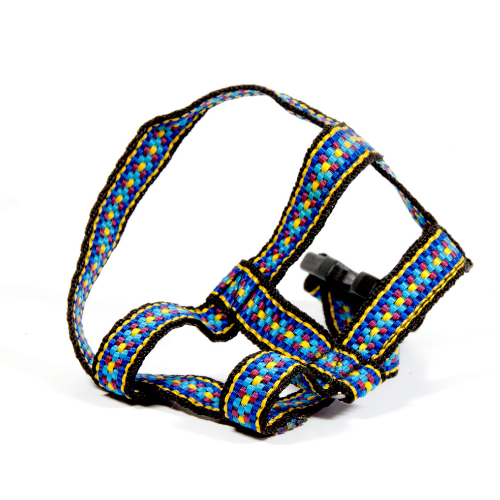
Padding
Practically all harnesses include some sort of padding to make your dog a bit more comfortable. Often, this padding is most heavy on your dog’s chest and back. While this padding may look awfully squishy and comfortable, you should remember that your dog isn’t actually going to spend much time putting pressure on the harness. Therefore, they aren’t going to press into this padding all that often.
If your dog is wearing the harness for extended periods, then the padding becomes more important. Dogs that are going to be laying down and sitting while wearing the harness may enjoy this extra comfort. However, if you are only taking your dog on a walk, this is less of a problem.
You can find some basic harnesses without any padding. These are designed largely for walking. Their main purpose is to be functional and keep your dog cool. A bunch of padding can easily retain heat and make your dog hotter than they would be otherwise.
Choose the amount of padding your dog needs based on when and where they will be wearing your harness. A harness that you only wear for walks needs to be different from one that will be worn all day.

Leash Ring Location
All harnesses will have a ring of some sort that is meant for a leash. You can almost always find these rings on the back of the harness, which is the typical location for a leash attachment.
However, more and more harnesses are providing attachments on the front of the harness near the chest. In this location, your dog is much less likely to pull. Instead of being able to lean their whole weight into pulling on the least, the front attachment prevents dogs from pulling on a leash at all. In fact, if they do pull, they will likely just get turned to the side.
For this reason, these attachments are becoming more and more popular with dogs that aren’t very good at walking on a leash. It can make walking much calmer. Usually, these are called “gentle walkers” or something similar, but some harnesses don’t use a special name to refer to them at all.
With that said, these harnesses aren’t all they’re cracked up to be. They are a very effective way to prevent your dog from pulling (since they literally prevent them from doing so). However, they do restrict proper shoulder movement in some cases, which can affect your dog’s gait. If a dog is walked like this enough, it can cause pain and even long-term damage.
However, it is really based on how you use these harnesses. You don’t want your dog to be pulling on it constantly as that’s when their gait is going to suffer. If your dog only pulls occasionally and you’re using other methods to prevent them from pulling, then the problems are going to be less extreme.
The major problems evolve when dog owners are relying heavily on the no-pull harnesses without using any training. They should be used as a tool – not as a Band-Aid.
Buckle System
Any harness that you choose should have an easy-to-use buckle system. At least at the beginning, your dog is likely going to struggle when you’re putting the harness on. Even if your dog doesn’t mind their harness, putting a harness on a dog that knows they’re about to go for a walk can be challenging!
Therefore, the best harness will have a buckle and strap system that is easy to use. Quick-release buckles are the best option, as they make taking the harness on and off much easier. However, other systems may also be suitable. The important thing is that you can easily take it off and put it back on.
Of course, it is also vital that the buckle system is durable and can withstand the level of wear that you’ll be placing on it. The last thing you want is for the buckle to break in the middle of a walk, for instance.
Largely, the buckle system you choose is largely up to you. You want to choose one that you feel comfortable quickly using with your canine. Of course, you won’t be able to try the harness out before you use it. Therefore, it is best to choose a type of buckle that you are already relatively comfortable with.
FAQs
The world of dog harnesses is surprisingly complicated and full of lots of debates. Below, we’ll answer some of the usual questions we receive about dog harnesses.
Are Dog Harnesses Bad?
It often doesn’t take long to find someone on the internet who claims that dog harnesses are the worst thing you can do to your canine. While there are some harnesses out there that can cause problems, most are completely safe. Typically, harnesses are much safer to use than a leash.
Collars can put a strain on your dog’s neck, especially if they tend to pull. Over time, this can cause damage to the thyroid, esophagus, and trachea. Certain breeds are more prone to problems than others, and luckily Dobermans don’t fall into this category. However, that doesn’t mean that you can’t protect their neck as much as possible.
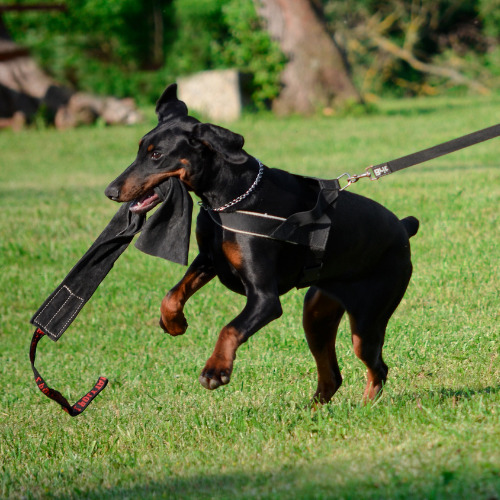
However, there are some poorly designed harnesses that can cause problems. Sizing is vital in this regard, as it helps ensure that the straps are where they need to be. The straps should be away from your dog’s joints. If your dog pulls, you don’t want their joints to receive the brunt of the force. Not only is this uncomfortable, but it can also cause damage over time.
Therefore, when sizing the harness for your dog, be sure that the straps sit as far away as possible from the joints.
The best thing about harnesses is that most dogs tolerate them quite well. As long as the dog does not have previous negative interactions with a harness (such as one that caused pain), they typically do not require much (if any) conditioning. On the other hand, gentle leaders and head collars require a lot of conditioning and most dogs find them uncomfortable.
In the end, while harnesses may not be a perfect solution, they are often the best option available.

What Kind of Harness is Best for Dogs?
The best harness is the one that fits your dog the best, truthfully. The fit of a harness is vital to its safest and useability. If a harness does not fit correctly, then it may cause joint problems, rub off fur, and be uncomfortable. Not only can a poorly fit harness lead to long-lasting problems, but it can also turn your dog off from harnesses, making it hard to switch them to a new one in the future.
Typically, any harness has the possibility of fitting well. However, you will need to measure your dog and use the company’s sizing chart to pick the best option.
With that said, some companies have poor sizing charts, and some harnesses are simply not very adjustable. In these cases, finding a good fit can be difficult.
Of course, you should also consider other features that you need. For instance, if your dog likes to swim, you should consider a water-proof option. A dog that only uses a harness for short walks will need a different harness than one that uses theirs for long car rides.
Which is Better: Dog Collar or Harness?
For most dogs, a harness is better – as long as it is fit properly. A collar can cause damage to the sensitive throat, while harnesses shouldn’t cause any damage.
However, certain dogs may not take well to any sort of equipment, including harnesses. In these cases, they may only be able to use a collar.
Neither option is absolutely perfect, but most dogs do much better with a harness.
Conclusion
Harnesses are a great option for most dogs. They don’t damage the throat, and they can even be designed to prevent pulling. However, it is vital to get the fit right, as a poorly fitting harness can cause all sorts of problems, including raw skin and joint problems.
Choosing the correct harness is vital, though. You want one that is adjustable to provide the best fit possible. Other features may matter on a case-by-case basis, such as the amount of padding. You’ll want to consider when and how long your dog will wear the harness before making your purchase.
If you plan on using a no-pull harness, be sure to research the proper technique required for walking with this training tool. While it can prevent pulling, it does require some technique to prevent gait issues.

Author: Kristin
Kristin was born in Tennessee and currently lives there with her husband and children. She is passionate about educating pet parents and helping them make the best possible decisions for their pets. She currently owns one dog, two cats, a lizard, and a variety of fish.

